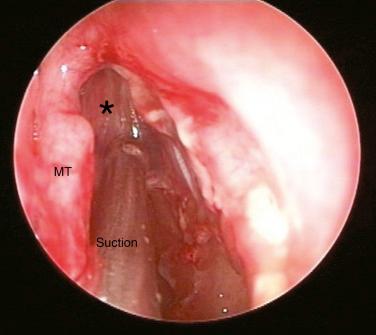Physical Address
304 North Cardinal St.
Dorchester Center, MA 02124
For many, postoperative débridement is considered a crucial aspect of optimizing endoscopic surgical results.
The most widely cited study supporting the practice of postoperative débridement is that of Senior et al., which suggested that weekly postoperative débridement was integral to the long-term improvement of symptoms in their series.
Several advantages to postoperative débridement have been described:
Impairment of mucociliary function persists for 3 to 12 weeks after surgery. Stagnant blood and mucus may act as a culture medium for microbes to perpetuate an immune response. Débridement reduces such colonization.
The removal of postoperative blood, fibrinous clot, mucus and bone fragments, and residual partitions may diminish the amount of postoperative inflammation and the potential for synechiae formation and middle turbinate lateralization.
Débridement improves patients’ postoperative symptoms and the endoscopic appearance of a healing sinus cavity.
The timing of postoperative débridements varies from surgeon to surgeon. In general, the patient returns for the first postoperative visit 5 to 7 days following surgery. A second postoperative visit is scheduled in 1 to 2 weeks, depending on the healing status of the sinonasal cavity. A third postoperative visit is often needed 4 to 5 weeks after surgery when the sinonasal cavity is nearly healed.
Patient discomfort may limit the extent of débridement. The use of topical anesthetics and vasoconstrictive agents is recommended.
Topical 4% cocaine solution can act as a potent anesthetic and vasoconstrictive agent.
It is often recommended that patients take a narcotic pain reliever before the initial postoperative débridement.
Minimal débridement should be undertaken if the indication for surgery included repair of cerebrospinal fluid leaks or skull base tumor resections.
0-degree and various angled endoscopes
Olive-tip suction
Frazier-tip suction
45-degree Blakesley forceps
0- and 45-degree through-cutting forceps
If a frontal sinus dissection has been performed, it is often easier to identify the natural recess in the office if a frontal sinus stent has been placed intraoperatively ( Fig. 12.1 ).

It is recommended that a full set of functional endoscopic sinus surgery instruments be available in the clinic for resection of retained bone fragments and recurrent polyps.
When instrumentation of the sinonasal cavity is performed, the nasal septum should be avoided, because it is often the most sensitive to the healing patient. Moving the instruments along the lateral nasal wall is generally better tolerated than moving them along the septum.
Talking to the patient while performing the débridement helps ease patient anxiety and improve patient comfort. A more comfortable patient often translates into a more compliant patient and more effective débridement.
For example, when the maxillary sinus is débrided, the patient should be warned that discomfort may be experienced in the teeth.
Become a Clinical Tree membership for Full access and enjoy Unlimited articles
If you are a member. Log in here